17 Health Benefits of Tadasana & How to Do It?
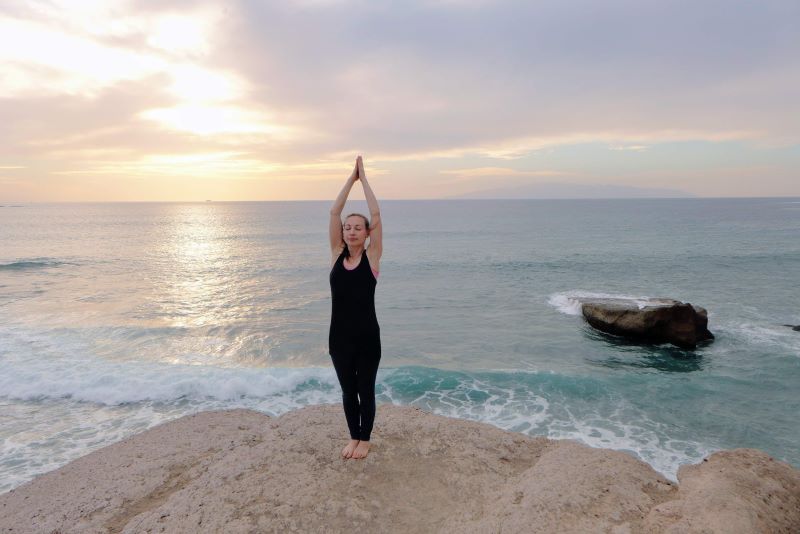
Tadasana is a classic yoga pose that is the foundation of all yoga asanas. It provides immense benefits to its practitioners. It provides strength and flexibility and enables us to manage our emotions better. If you are suffering from any chronic disease or recovering after surgery, practising yoga can be beneficial if you add it to your daily routine.

Table of Contents

What is Tadasana (Mountain Pose)?
Tadasana is a Sanskrit word. While tada means mountain, asana means posture or pose. So, we get the phrase Mountain Pose by combining these two Sanskrit words. It is the foundation or base for all standing poses in yoga.
Tadasana is an excellent pose for standing or resting. You can also practise this asana to improve your posture. Moreover, it is the starting and finishing position for many important asanas, like the Surya Namaskar.
How to Perform Tadasana?
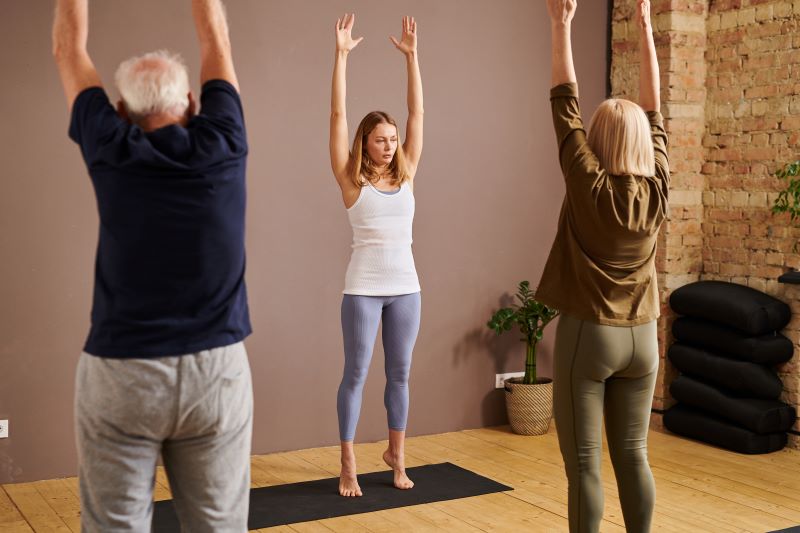
Given below is a step-by-step guide for performing the Tadasana pose:
Step 1: Maintain a straight posture and two inches between your feet.
Step 2: Raise your arms in front of you and take a breath to level up to your shoulders.
Step 3: Rotate your wrist outward after locking the fingers of one hand with the other.
Step 4: Now breathe in and lift your arms above the head.
17 Health Benefits of Tadasana
Listed below are the various health benefits of practising tadasana:
1. Improves Flexibility
If you consistently practise Tadasana, you will experience improved flexibility. If you practise it correctly, you will realise that you can bend your back further and with ease. Moreover, it also helps you build up your strength and stability.
2. Helps in Managing Back Pain
This asana is beneficial if you suffer from back pain. Correctly and regularly performing Tadasana can mitigate your spinal and neck pain. You will get better management guidance if you practise yoga with a qualified instructor who knows all your medical issues.
3. Improves Breathing
A great benefit of tadasana yoga is that it opens the lungs and helps you breathe in more deeply. This benefit must be supported because we live amidst air pollution in the twenty-first century. This is because Tadasana helps in unclogging our lungs.
4. Boosts Energy Levels
This yoga posture helps rejuvenate our mind, body and soul. One can use Tadasana to cultivate stillness and strength and prepare the mind and body for the next asana.
5. Promotes Weight Loss
Tadasana is also responsible for improving metabolism. This asana helps the practitioner burn more calories. If you wish to lose weight, you can try practising yogas utilising Tadasana.
6. Improves Mental Awareness
Yoga plays a vital role in boosting our mental awareness. This is because it lays equal stress upon our physical and psychological well-being. Tadasana helps us connect with our in-depth consciousness and assists us in improving our mental awareness. It makes us more composed, calm and alert.
7. Provides Relief from Sciatica Pain
The pain that radiates from the Sciatic nerve is called Sciatica pain. The pain pierces the lower back through the hips and buttocks down each leg. Generally, Sciatica pain affects only one side of the body. If you are suffering from sciatica pain, try practising Tadasana correctly, as it will mitigate pain and strengthen the muscles.
8. Develops Better Balance
While practising Tadasana, you need to stand tall and straight. Therefore, this yoga posture ensures that you improve your sense of balance.
9. Effective in Treating COPD (Chronic Obstructive Pulmonary Disease)
COPD (Chronic Obstructive Pulmonary Disease) is an inflammatory lung disease that is chronic. It hampers airflow from the lungs, which causes cough, mucus, and wheezing and makes breathing difficult. If people practise Tadasana, it will reduce stress and anxiety and improve strength and balance. COPD patients can also gain a sense of stability.
10. Helpful in Parkinson’s Disease
Consistently practising Tadasana helps strengthen the lower body. As a result, one can benefit from improved posture and balance. Patients with Parkinson's disease can greatly benefit from practising this asana regularly.
11. Reduces Pain Related to Ankylosing Spondylitis (AS)
If you are suffering from Ankylosing Spondylitis (AS), you can try practising Tadasana. It has shown some effectiveness in reducing AS-related pain. Moreover, it improves posture and flexibility.
12. Enhances Blood Circulation
Practising Tadasana helps enhance blood circulation throughout the body. Improved circulation ensures that oxygen and nutrients are effectively distributed to all body parts, promoting overall health.
13. Alleviates Stress and Anxiety
Engaging in Tadasana regularly can help alleviate stress and anxiety. The pose encourages deep breathing and mindfulness, which are essential for calming the mind and reducing stress.
14. Strengthens the Immune System
Regular practice of Tadasana can contribute to a more robust immune system. By improving blood circulation and reducing stress, this asana helps in bolstering the body's natural defence mechanisms.
15. Improves Posture
Tadasana is instrumental in correcting posture. Aligning the spine and engaging the core muscles helps individuals maintain an upright and healthy posture, reducing the risk of postural deformities.
16. Enhances Digestion
This pose aids in the proper functioning of the digestive system. Tadasana can help alleviate digestive issues such as bloating and constipation by engaging the core and promoting relaxation.
17. Boosts Confidence and Self-Esteem
Practising Tadasana regularly can boost confidence and self-esteem. The pose encourages a sense of stability and strength, fostering a positive self-image and greater self-assurance.
The Mudras of Tadasana (Mountain Pose)
Mudras, or hand gestures, play a significant role in enhancing the benefits of yoga asanas. In Tadasana, incorporating specific mudras can amplify the physical and mental benefits of the pose.
1. Gyan Mudra
In Tadasana, incorporate Gyan Mudra by gently bringing the tips of your thumbs and index fingers together while standing tall with feet hip-width apart. This gesture of knowledge enhances focus and mental clarity, amplifying the meditative aspect of the pose.
Benefits of Gyan Mudra: This mudra promotes mental clarity, concentration, and calmness. It promotes a sense of calmness and relaxation, reducing stress and anxiety
2. Anjali Mudra
Use Anjali Mudra, or the Gesture of Reverence, by bringing your palms together above your head, pointing upwards. This gesture of reverence cultivates inner peace and balance, deepening the meditative quality of the pose.
Benefits of Prana Mudra: This mudra helps centre the mind and promote inner peace, enhancing the meditative aspect of Tadasana. It balances the energy between the left and right sides of the body, fostering a sense of harmony and balance.
3. Apana Mudra
To integrate Apana Mudra in Tadasana, touch the tips of your thumb, middle finger, and ring finger together, maintaining the straightness of your other fingers. This movement grounding and detoxifying the body adds to the pose's overall health benefits.
Benefits of Apana Mudra: This mudra helps detoxify the body by stimulating the excretory system. It balances the body's energies, promoting a sense of grounding and stability.
Types of Tadasana
While Tadasana is traditionally a straightforward pose, variations exist to enhance its benefits and cater to different levels of practice. Here are three types of Tadasana:
1. Basic Tadasana (Mountain Pose)

In the Basic Tadasana, practitioners stand with feet together or hip-width apart, arms relaxed at the sides and focus on grounding through the feet. This foundational pose emphasises alignment, stability, and breath awareness. It helps improve posture, balance, and overall body awareness, and it is the starting point for many other yoga poses.
2. Tadasana Urdhva Hastasana (Mountain Pose with Raised Hands)
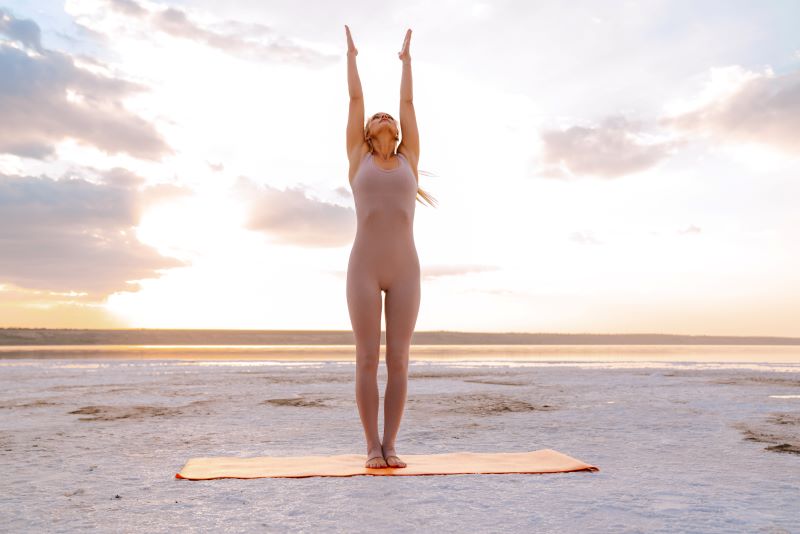
In Tadasana Urdhva Hastasana, the arms are extended overhead with palms facing each other or touching. This variation stretches the torso, shoulders, and arms, enhancing the benefits of the basic pose. It encourages deeper breathing and helps in elongating the spine, improving overall body alignment and strength.
3. Tadasana Samasthiti (Equal Standing Pose)
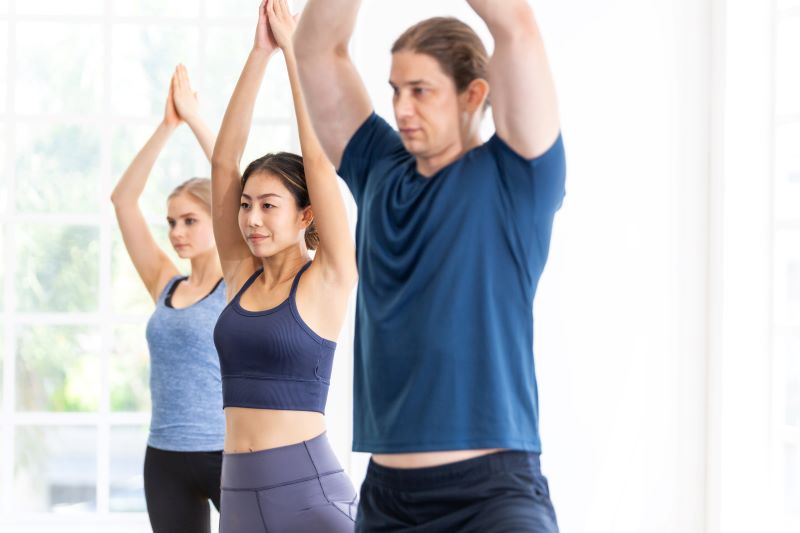
Tadasana Samasthiti, also known as Equal Standing Pose, is a variation where the focus is on achieving perfect symmetry and balance in the body. Feet are together, hands are in Anjali Mudra (prayer position) at the heart centre, and the weight is evenly distributed.
This pose fosters a sense of calm and centredness, making it ideal for grounding and mental clarity. It also prepares the body for meditation and other standing poses.
Things to Know Before Doing Tadasana Yoga
Before practising Tadasana, it is essential to understand certain key aspects to maximise its benefits and ensure safety. This foundational pose requires proper technique and awareness to achieve the best results.
- Proper Alignment: Ensure your feet are parallel and hip-width apart, with weight evenly distributed. Focus on aligning your ears, shoulders, hips, and ankles in one straight line to maintain correct posture.
- Breathing: Focus on deep, steady breaths to enhance the pose's benefits and relaxation. Breathing profoundly helps open up the chest and improve lung capacity, contributing to overall calmness and mental clarity.
- Foot Placement: Ground your feet firmly to create a stable base for balance and posture. Press evenly through all four corners of your feet and lift your arches slightly to activate the legs and build a strong foundation.
- Avoid Overstretching: Maintain a gentle core activation and avoid locking the knees. Overstretching can lead to injury, so it’s essential to keep a slight bend in the knees and engage the abdominal muscles for support.
- Wear Comfortable Clothing: Wear comfortable clothes that allow free movement and don't restrict your breath. Tight or restrictive clothing can impede your ability to move freely and breathe deeply, which is essential for maintaining proper form and relaxation.
How Long to Hold Tadasana Pose?
The duration of holding Tadasana varies based on individual practice and comfort level. It focuses on breath awareness, alignment, and gradual progression.
- For Beginners: Start by holding the pose for 30 seconds to a minute to gradually build strength and endurance. Listen to your body and avoid straining, focusing on proper alignment and steady breathing.
- For Intermediate Practitioners: Progress to holding Tadasana for 2-3 minutes, gradually increasing duration as you become more comfortable and confident in the pose. Focus on maintaining alignment and deepening your breath for enhanced benefits.
- For Advanced Practitioners: Hold Tadasana for longer durations, up to 5 minutes or more, focusing on refining alignment, breath control, and inner awareness. Explore subtle adjustments and variations to deepen your practice and experience the full potential of the pose.
Risks of Overdoing Tadasana
While Tadasana offers numerous benefits when practised mindfully, overdoing the pose can lead to potential risks and discomfort, exceptionally if proper alignment and technique are not maintained.
- Muscle Strain: Overdoing Tadasana may lead to muscle strain, particularly in the legs, back, and shoulders, if the pose is held for too long or performed with incorrect alignment.
- Joint Compression: Excessive force or overextension in Tadasana can compress the joints, especially the knees and spine, increasing the risk of injury or aggravating existing joint issues.
- Fatigue and Exhaustion: Holding Tadasana for extended periods without adequate rest can lead to fatigue and exhaustion, as it requires continuous muscle engagement and focus on breath awareness.
- Increased Stress on Heart: Intense or prolonged practice of Tadasana without proper supervision can elevate heart rate and blood pressure, potentially straining the cardiovascular system.
- Risk of Falls: Overdoing Tadasana, especially for those with balance issues or weak muscles, may increase the risk of falls or loss of balance, leading to injury.
Important Tips for Practising Tadasana
Listed below are a few tips that will help you practise the Mountain Pose optimally:
- Activate Your Core Gently: Remember that your stance is critical. Try to activate your core gently. This will maintain a strong stance and retain the integrity of the pose. Additionally, it will prevent you from locking your joints.
- Focus on Proper Alignment: It is a good idea to align your ears, shoulders, neck and hips above the ankle. The body weight should be evenly placed on both feet. Make sure you do not collapse into the arches of your feet. Moreover, do not turn your feet in other directions than the ones specified.
- Feel the Transfer of Energy: It would help if you tried to imagine a line of energy moving from your feet, through your legs and spine to your head. Then, you can feel the transfer of energy more effectively.
- Focus on Your Feet: Some people like placing their feet together. However, others prefer keeping their feet at hip-width apart. The ideal position depends on where the practitioner is comfortable balancing his/her body weight adequately.
- Close Your Eyes: It is a good idea to close your eyes while performing Tadasana yoga. Closing your eyes leads to a loss of visual reference that aids in balance. As a result, you have to rely entirely on your body to maintain balance and posture.
- Use a Wall: If you find it challenging to maintain balance or find a centre, you can use a wall as support. It would help you get into the proper position.
What are the Precautions and Contraindications of Tadasana?
Before you practise Tadasana, you need to keep in mind the following precautions and contraindications:
Remember that proper form and technique are essential for reaping benefits from Tadasana.
If you have a pre-existing condition for which you feel you need to seek professional help, consult a medical practitioner before you try this exercise.
Beginners, who have never practised Tadasana before, should do it with extra caution. Moreover, if they find it challenging to maintain a connection between their body and their breath, they must do this pose under the guidance of a certified yoga instructor.
Additionally, people who have weak physical strength should seek the guidance of a yoga instructor before practising Tadasana.
While practising it, you must stop immediately if you suffer from a headache.
If by any chance you consume blood thinning medications, consult a doctor before doing this yoga pose.
Wear comfortable clothes and shoes before going through the steps of Tadasana.
Do not consume heavy meals before doing yoga.
Make sure that you are adequately hydrated before doing Tadasana.
Patients who have undergone spinal, ankle knee or hip surgeries or surgeries should avoid practising this yoga pose. Practising Tadasana requires them to keep standing for a long time. This might aggravate injuries.
Patients with migraine and vertigo issues must refrain from performing the mountain pose.
Moreover, people with low or high blood pressure should avoid performing this yoga pose.
Pregnant women should avoid Tadasana. This is because their body might experience imbalance due to the weight of the womb.
Tadasana may also not be an ideal yoga pose for senior citizens as they might experience weakness.
While it is true that practising Tadasana might be effective for treating spinal disorders like scoliosis, kyphosis and herniated discs, people who are affected by these disorders should take into account essential factors before practising Tadasana. For example, they should not also suffer from high blood pressure, migraines, or vertigo.
If anyone finds it difficult to stand for a long time, Tadasana is not an ideal yoga pose for them.
People who suffer from locked knees should not practise this asana.
Who Should Avoid Doing Tadasana?
While Tadasana (Mountain Pose) offers numerous benefits, specific individuals should exercise caution or avoid practising this pose altogether due to particular health conditions or limitations.
- Pregnant Women: Pregnant women, especially those in the later stages of pregnancy, should avoid Tadasana as it involves prolonged standing and may cause discomfort or imbalance due to the shifting centre of gravity. Pregnant women should consult with their healthcare provider before attempting any new yoga poses.
- Individuals with Low or High Blood Pressure: Those with low or high blood pressure should approach Tadasana cautiously, as the pose may affect blood circulation and blood pressure regulation. Individuals with hypertension or hypotension should consult with a healthcare professional before practising Tadasana.
- People with Vertigo or Balance Issues: Individuals who experience vertigo or have balance issues should avoid Tadasana, as it involves standing upright for an extended period and may exacerbate feelings of dizziness or instability. It's essential to prioritise safety and stability during yoga practice.
- Recent Surgery or Injury: Individuals who have undergone recent surgery, particularly involving the spine, knees, hips, or ankles, should avoid Tadasana until they have fully recovered and received clearance from their healthcare provider. Practising yoga poses prematurely after surgery or injury may impede healing or cause further damage.
- Severe Joint Pain or Injuries: Those experiencing severe joint pain or injuries, such as arthritis, should avoid Tadasana or modify the pose under the guidance of a qualified yoga instructor or healthcare professional. Putting excessive stress on injured joints may exacerbate pain or lead to further injury.
- People with Migraines: Individuals who suffer from frequent migraines should approach Tadasana with caution, as the pose may aggravate headache symptoms or trigger a migraine attack. Listening to your body and avoiding movements or positions that exacerbate migraine symptoms is essential.
Individuals with specific health concerns or limitations must consult with a healthcare provider or certified yoga instructor before attempting Tadasana, or any new yoga poses to ensure safety and suitability for their unique needs.
What are the Easy Modifications of Tadasana?
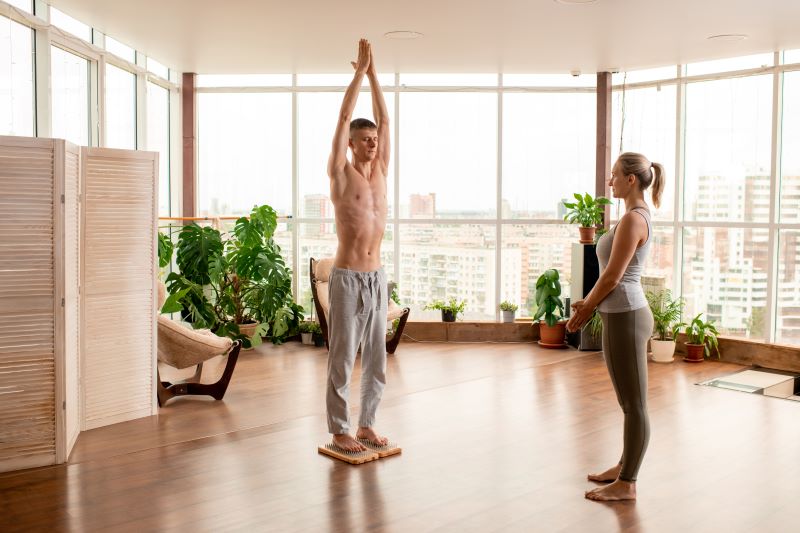
While this yoga asana may seem easy, it requires optimal body posture and muscle strength. Hence, follow the easy modifications to utilise maximum benefits:
- Block Between the Wall and Upper/Middle Back: If your chest falls easily while performing this asana, place a block between the middle of the back and the wall. This will help you support your lower back and tone your hips.
- Block Between the Wall and Lower Back: You may struggle to raise your hips and lower back. In such cases, place a block on the wall and support it with your lower back. This will help to tone your hips.
- Spread Your Legs: If you fail to maintain balance with toes or feet together, maintain a foot distance between your feet. Keep reducing the distance over time as you are comfortable.
- Use a Yoga Pad: As you hold the pose for some time, you may feel a burning sensation. Keep a yoga pad mat below your feet and ensure it is firm.
- Keep Your Eyes Open: In case you are not confident enough to try out tadasana with closed eyes, keep them open.
To sum up, Tadasana or the Mountain Pose is not just the foundation of all other yoga poses. It is also an effective exercise on its own, as it successfully strengthens the lower part of the body. Furthermore, it improves one’s self-awareness. So, do not wait longer. Incorporate Tadasana into your daily routine to lead a healthy life.













